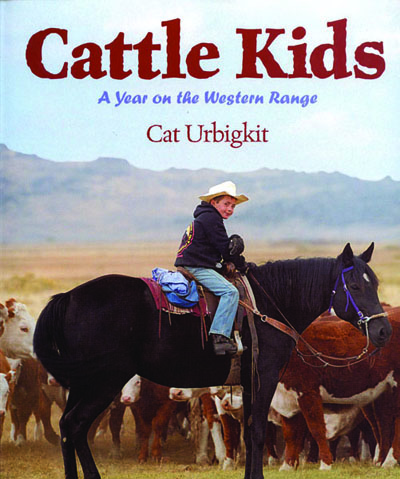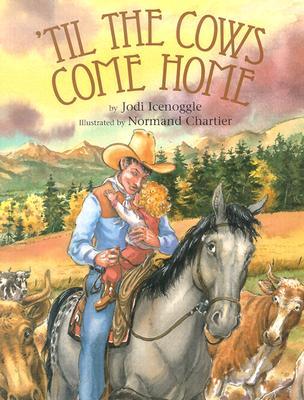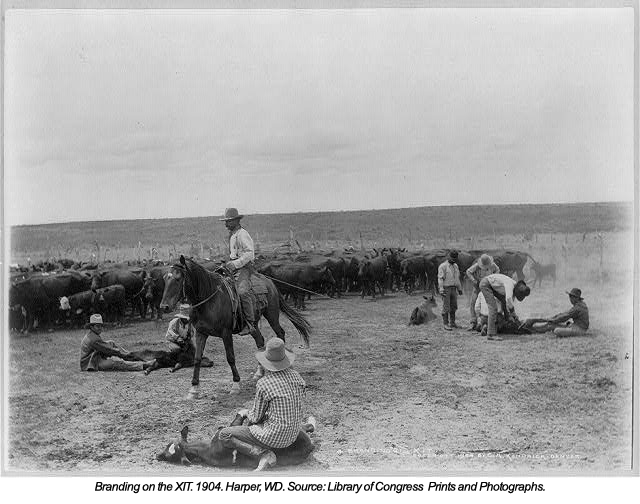Agricultural Literacy Curriculum Matrix
Lesson Plan
Making a Brand for Ourselves the "Cowboy" Way
Grade Level
Purpose
Students explore cowboy culture and history and research 19th-century Texas cattle trails by writing cowboy poetry, mapping historic cattle trails, and creating cattle brands. Grades 3-5
Estimated Time
Materials Needed
 Engage:
Engage:
- K-W-L Charts reference page
- Butcher paper or easel pad
- Student notebooks or teacher-prepared K-W-L charts
Activity 1: Cowboys/Cowgirls
- Cattle Kids by Cat Urbigkit
- ‘Til the Cows Come Home by Jodi Icenoggle
- Cowboy/Cowgirl Gear activity sheet, 1 per student
- Western Folklife Center Cowboy Poetry and Music web page
Activity 2: Trail and Grazing Geography
- Cattle Trails Map, 1 per student
- Optional: The Cattle Trail (1879) video and/or Chisholm Trail Brochure
- Continental United States Map, 1 per student
 Utah Grazing Allotment Map, 1 per student
Utah Grazing Allotment Map, 1 per student
Activity 3: What's Your Brand
- Decoding the Range: The Secret Language of Cattle Branding web page
- History of Branding: Irons in the Fire video
- Pipe cleaners, 2 per student
Activity 4: Balloon Brand Roundup
- Black permanent marker, 1 per group
- Balloons, 10 per group
- Large garbage bag
Vocabulary
livestock: farm animals (such as cows, horses, and pigs) that are kept, raised, and used by people
ranch: a place for the raising of livestock (such as cattle, horses, or sheep) on range
rangeland: large, mostly unimproved section of land that is primarily used for grazing livestock
Did You Know?
- There are approximately 770 million acres of rangelands in the United States.1
- 74 threatened or endangered species can be found just on rangelands managed by the Bureau of Land Management (BLM).1
- Rangelands provide products like forage, wildlife habitat, water, minerals, energy, recreational opportunities, and some wood products.1
- The primary use of rangelands is livestock grazing to produce food and fiber.1
Background Agricultural Connections
Rangelands play an important role in agricultural production, especially in the western United States. Today, the term "rangeland" refers to a large, mostly unimproved section of land that is primarily used for grazing livestock. Rangelands are usually mountainous, rocky, or dry areas that aren’t suitable for growing the usual farm crops. However, grass and other plants on this rangeland can be used for grazing livestock. People can’t eat grass and shrubs, but grazing cattle and sheep produce beef and lamb as well as leather, wool, and other by-products.
There are about 770 million acres of rangelands in the United States. More than half of this land is privately owned, 43 percent is managed by the federal government, and the remainder is managed by state and local governments. In addition to supporting livestock, rangelands also provide important habitat for a wide variety of wildlife. In Utah, rangelands cover about 80 percent of the state, including desert canyons, expansive shrublands, and spectacular mountains. With so much rangeland, it is no wonder that ranches and the cowboys and cowgirls that work on them have made a mark on Utah culture.
Privately owned rangelands that are used to raise livestock are often called ranches, and the people that work on a ranch with livestock are commonly called cowboys or cowgirls. The word “cowboy” probably came to the English language as a direct translation of the Spanish word “vaqeuro” (from the word “vaca,” meaning “cow”), which refers to a person who works with cattle while riding a horse. The word “cowboy” first appeared in the English language in about 1715, but the widely recognized image of the cowboy originated on the cattle trails of the 19th century.
In 19th-century Texas, there was an abundance of cattle, but the markets for selling cattle were far off in the north. Following the Civil War, ranchers began to drive their cattle to the nearest railroad to be shipped to market. Cowboys drove huge numbers of cattle north across Texas. In just the year of 1871, approximately 700,000 cattle were moved from Texas to railroad shipping yards in Kansas. The cattle trails that arose during the late 19th century established the image of the American cowboy in our national consciousness and are an important part of American history.
The work of cowboys and cowgirls is difficult and physically demanding. Because of this, cowboys historically started learning the trade at an early age, usually around 12 or 13 years old. In the United States, a few women also took on the tasks of ranching and learned the necessary skills. Although there are few early records of women working cattle, it is certain that throughout the history of the western United States women did considerable ranch work and, in some cases, ran the ranches. Wives and daughters of men who owned small ranches and could not afford to hire outside help would have worked with the men, riding horses and performing the many other tasks required of running a ranch.
On a ranch today, the cowboy or cowgirl is usually an adult, but because most ranches are owned by families, both boys and girls that grow up on the ranch often learn how to ride horses and perform other basic ranch skills as soon as they are physically able. A cowboy/girl has many responsibilities, such as gathering calves in the spring for branding. Calves are branded with a hot iron shaped into the ranch’s symbol, which marks the animal for life. This way if the animal is ever lost or stolen, its owner can still be easily identified. Other responsibilities that fall to the cowboy/girl include vaccinating cattle to protect them from disease, moving livestock to different pastures, repairing fences, maintaining ranch equipment, and feeding livestock in the winter when grazing isn’t an option.
To accomplish these tasks, most cowboys/girls wear clothing commonly called western wear, or cowboy/girl gear, which is worn out of a practical need and is designed to stand up to rough working conditions.
Engage
- Before beginning the activity, create a K-W-L chart (see K-W-L Charts page) on a large sheet of butcher paper or an easel pad that will be posted in the classroom and referred to during class study of cowboy/girl culture and history.
- Explain how to make and use a K-W-L chart. Have students make their own K-W-L Charts, or distribute one that you have prepared.
- Have students fill in the “K” column with everything they already know about cowboy/girl culture and history (this will help activate prior knowledge).
- Then have students fill in the “W” column by predicting what they think they will learn (this will help them focus on key ideas and set their purpose for learning).
- Post the class K-W-L chart previously prepared on butcher paper. Have students share their responses from the “K” section of their K-W-L charts and take turns writing their ideas on the paper. Discuss student responses. Do the same with the “W” section of the chart.
Explore and Explain
Activity 1: Cowboys/Cowgirls
- Ask your students how old they think cowboys/girls usually are. Introduce and read the book Cattle Kids to your students.
- After reading Cattle Kids, use the following discussion questions to explore what students learned:
- Are there still cowboys/girls today? What do they do? Do they still have cows? Where do they keep their cows? In the winter? In the summer?
- How does the cowboy/girl tell which cows belong to them?
- How do cowboys/girls gather and move their cattle?
- What type of clothing and gear does a cowboy/girl need?
- What products come from the cattle raised by cowboys/girls? (beef and by-products like leather)
- Read the book ’Til the Cows Come Home, and discuss the different kinds of gear a cowboy/girl may use and wear as well as the different kinds of words and phrases used in the book. (Note: At the back of the book, there are some “Western Words and Phrases” you can introduce your students to, including: doggies, heifer, hornswoggled, finer than frog’s hair, Jim dandy, sawing the fiddle, shindig, and wrangler.)
- Pass out the Cowboy/Cowgirl Gear activity sheet to your students, and ask them to label the different types of gear. As a class, discuss why cowboys/girls would use each item.
- Visit the Western Folklife Center Cowboy Poetry and Music page to introduce your students to cowboy/girl songs and poetry.
- As a class, write an “add-a-word” poem about cowboys/girls. Begin with the words “A cowboy” or “A cowgirl.” Then go around the class and have each student add a new word that describes a cowboy/girl to create the next line of the poem. In each line, a new word is added and the rest is repeated. This poem can be long or short, depending on ability and time availability.
A cowboy (cowgirl)
A bowlegged cowboy
A happy, bowlegged cowboy…
- After the class poem is written, have students write their own poetry using the vocabulary they have learned about cowboys/girls (visit poets.org for more resources on exploring poetry with your students).
- Ask students to add two to three things they have learned to the “L” section of their individual K-W-L charts. Then have students share their responses with the class and record them on the class chart.

Activity 2: Trail & Grazing Geography
- Using the information from the Cattle Kids book, discuss the differences between cowboys/girls of the past (1880s) and those of today. Construct a Venn diagram to compare and contrast the past and present.
- Review with your students the four major historical cattle drive trails using the Cattle Trails Map. Discuss the circumstances that led to the great Texas cattle drives and how methods for getting cattle to market have changed over time. For more information on cattle trails, explore the optional resources given below.
- Optional: Share the Chisholm Trail Brochure with students. Consider dividing students into groups and providing each group with a page from the brochure. Instruct groups to read their page and then present the most important points to the rest of the class.
- Optional: Share the American West video The Cattle Trail (1879) with your students.
- Provide each student with a copy of the Continental United States Map. Instruct students to label the cattle trails and the modern-day states and cities that were affected by the cattle drives.
- Define the term “rangeland” and discuss the uses and importance of rangeland with students. Explain that rangelands are generally not suitable for growing crops, but they can be grazed by livestock to produce meat products like beef and lamb as well as by-products like leather and wool.
- Using the Utah Grazing Allotment Map (project the map for the whole class to see or print one map per student), ask students to identify where they think Utah ranchers would range their cattle in the winter and summer months. Note that the white area on the map may be private land, military bases or wilderness, and that 40% of the cattle in Utah are raised on private land only. (As a rule of thumb, drier, warmer, and lower elevations are winter range; conversely, wetter, cooler, and higher elevations are summer range).
- Note: to adapt this lesson to other states, find a state map that shows land that is or could be used for grazing.
- Ask students to add something they have learned to the “L” section of their individual K-W-L charts. Then have students share their responses with the class and record them on the class chart.
 Activity 3: What’s Your Brand?
Activity 3: What’s Your Brand?
- Use the Decoding the Range: The Secret Language of Cattle Branding Smithsonian web page and the History of Branding: Irons in the Fire video as resources to discuss cattle branding with your students.
- Discuss how cattle brands are designed and what makes them different from one another (placement on the animal as well as design).
- Have your students create and design their own brands using pipe cleaners. Distribute two pipe cleaners per student. Explain that brands cannot be complicated because they are made out of a piece of metal. Have students bend pipe cleaners into their own brand using the following rules:
- Brands are read left to right, top to bottom, and outside to inside.
- Letters and numbers represent those actual letters and numbers.
- Letters are always capital letters.
- A letter laid on its side is called a “lazy” letter.
- An upside down letter is read as “crazy.”
- A backwards letter is read as “reverse.”
- M and W cannot be used upside down because they would look like each other.
- A cursive letter that could be written without lifting up the pencil is read as “running.”
- Pictures can be used such as quarter moon, half moon, sun, diamond, triangle, heart and #.
- — is read as “bar,” _____ is read as “rail,” and / is read as “slash.”
- You can put a number or letter in a box.
Activity 4: Balloon Brand Roundup
- After students complete Activity 3 and have created their own brands, they will be responsible for “branding” their own “cattle.” Separate students into ten families, and provide each family with ten cattle (balloons which they should blow up) and one permanent marker. Instruct the students to choose one brand per family and apply it to each of their cattle by tracing their pipe cleaner brand with the permanent marker.
- Explain that all families will release the cattle to graze in one area that you have designated as open range. A large livestock truck will transport the cattle to open range. You can either appoint one student or personally be the truck driver who goes from ranch to ranch with the livestock truck (large garbage bag).
- Release the cattle by dumping the balloons out in the designated area. Walk through the cattle to thoroughly mix them up.
- Have the students round up their cattle. Discuss the importance of branding, and ask students how they would find their cattle if they didn’t have brands.
- Have a second roundup, but this time keep a permanent marker for yourself as a “running iron.” Change some students’ brands to your own so that when they go to round up their cattle they are missing some—cattle that you have rustled and now get to sell at the marketplace.
- Discuss with the students the importance of the brand and the role of cattle rustlers. Discuss the loss in revenue caused by cattle rustlers and how the students feel about rustlers.
- Optional: Try the balloon brand roundup outside with wind. Try to have the students keep track of their balloons. Discuss the role of fences and how that changed ranching. Does it lessen the importance of branding?
Elaborate
-
As a class, develop a timeline of historical occurrences in the United States, including the expansion of the railroad, that affected the cowboy/girl and livestock production. Use the Bullock Museum's Cattle Folk page as a reference.
-
Use the lesson plan At Home on the Range to further explore rangelands as ecosystems, productive landscapes, and an important part of western culture.
-
Play the My American Farm interactive game The Steaks are High.
Evaluate
- Have students complete the “L” section of their individual K-W-L charts, documenting additional things they have learned. Then have students share their responses with the class and record them on the class chart.
- Review and summarize the following key concepts:
- Cowboys and cowgirls use rangelands to raise cattle that provide consumers with beef as well as by-products like leather.
- The Texas cattle trails of the 19th century were important in establishing American cowboy/girl culture.
- The work of cowboys/girls has changed in some ways over time but in other ways remains the same.
- The land area of Utah and many other western states is dominated by rangelands, which are widely used to raise livestock.
- Cowboy/girl culture has had an important impact on American culture, especially in western states.
Acknowledgements
Activity 4 was adapted with permission from Nevada Agriculture in the Classroom.
Recommended Companion Resources
- 'Til the Cows Come Home
- America's Heartland: Riding the Range on a Utah Cattle Drive
- Cattle Kids: A Year On the Western Trail
- Farm Pop-Ups
- Glidden's Patent Application for Barbed Wire
- Illustrated Accounts of Moments in Agricultural History
- Lazy B: Growing Up on a Cattle Ranch in the American Southwest
- Levi's Lost Calf
- NMSU Field Trip: Beef
- TedTalk- How to Fight Desertification and Reverse Climate Change
- The Shepherd's Trail
- The Steaks Are High Online Game
- Thunder Rose
- Tootsie Roll Conversation About Conservation Terms
- Utah Agriculture Activity Map
- Utah Beefscapes
- Why Can a Cow Eat Grass? Video
Author
Organization
| We welcome your feedback! If you have a question about this lesson or would like to report a broken link, please send us an email. If you have used this lesson and are willing to share your experience, we will provide you with a coupon code for 10% off your next purchase at AgClassroomStore. |
